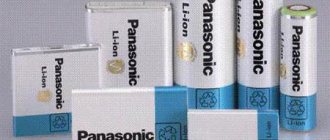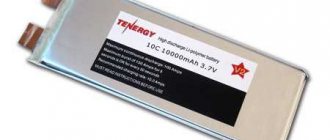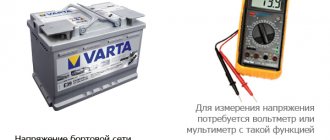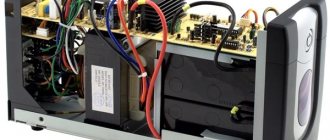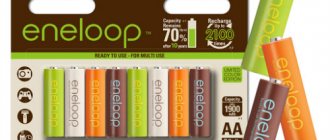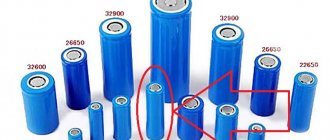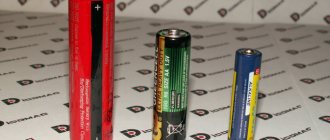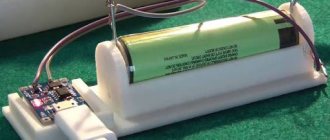Modern gadgets use more and more lithium polymer batteries. This type of battery appeared not so long ago. Their design and materials used are gradually being improved. Li-Pol batteries can be found in tablets, some models of smartphones and laptops. They are also widely used in radio-controlled toys and models. We get quite a lot of questions about how to charge such batteries. This has already been mentioned in some articles. Since this topic is in great demand, we decided to include it in a separate post.
Features of lithium polymer (Li-pol) batteries
Lithium is the lightest of the metals and has the highest electrochemical potential, providing high energy density. During operation, such a battery uses lithium metal electrodes.
Both polymer and ion batteries are significantly more efficient than their predecessors - nickel-cadmium and nickel-metal hydride batteries. Modern batteries have a much higher capacity, more charge/discharge cycles, no “memory effect”, and are more compact in size.
In terms of compactness, polymer batteries (Li-pol) occupy first place. These batteries use a polymer - a thin and flexible plate impregnated with electrolytes. Due to its compactness, the battery is only 1 mm thick. Such compact batteries allow designers to design smaller, lighter smartphones.
Main advantages of Li-pol batteries:
- The flexible polymer will make it possible to achieve smaller battery sizes, resulting in compact devices. In this parameter, polymer batteries are preferable to ion batteries, since the latter have reached the limit of thickness reduction.
- This battery is considered the most advanced, and therefore provides a greater level of safety, reducing the risk of overcharging and leakage of electrolytes.
- Polymer batteries have a longer service life, slower aging and self-discharge.
- Polymer batteries have a higher cost of materials for manufacturing (compared to ion batteries). Ultimately, this affects the price of the phone.
- High sensitivity to low temperatures.
- They heat up more.
Main characteristics
As we have already found out, the characteristics of lithium-polymer cells are in many ways similar to lithium-ion ones. They work on the same principle, have approximately the same service life and number of charge/discharge cycles. They are equally afraid of overcharging and deep discharge and do not have a memory effect. But Li-pol still has differences. Here are the main ones:
- higher energy intensity with the same dimensions;
- low risk of fire;
- complete absence of explosion hazard;
- small thickness and almost any form factor;
- the operating temperature range is slightly lower (-20 ... +40 versus -20 ... +60 degrees Celsius);
- lower voltage drop during discharge (4.2-3.0 V versus 4.2-2.5 V for Li-ion);
- higher cost.
Important! The main advantage, of course, is increased security. Even if used incorrectly, it is very difficult to set fire, let alone explode, a Li-pol element.
How to properly charge a lithium polymer battery?
Whatever battery is installed in a smartphone, without proper care it will quickly begin to wear out and lose capacity. Protect your phone from overheating and hypothermia. High temperatures can cause fire. As for low temperatures, in cold weather the battery's current output decreases due to a slowdown in the chemical reactions of the electrolytes. This is why mobile devices often turn off in extreme cold - a kind of self-defense.
To extend the life of your lithium polymer battery, charge it correctly and follow basic tips and tricks. Remember that many batteries are sensitive to temperature changes and complete discharges.
Modern batteries have a special controller installed that protects the smartphone from overcharging and overdischarging. It prevents the device from continuing to power the device after reaching 100% of the restored capacity, even if the charger cable is connected to the network. When the phone is completely turned off due to battery depletion, there is always some power left in the battery, since the controller turns off the device in advance. However, the phone needs to be charged as soon as possible after this.
Ideally, the device should not be allowed to completely discharge. Some experts recommend not charging the gadget above 90% and not discharging below 10% - this can extend the battery life. The exception is preventative calibration once every six months. To do this, you need to completely discharge your smartphone and then charge the battery to 100%.
When buying a new smartphone, it is important to follow simple rules for the first charge.
Video to watch: How and with what to charge Li-ion and Li-po batteries 18650, from a mobile phone, etc. Tp4056
There are universal chargers that are suitable for connecting both to 220V household appliances and to a 12V on-board network. All of them are equipped with a housing, cable with plug, converter in the form of a transformer, voltage stabilizer, charging control and LED indicator.
In addition, some models have other elements - for example, a voltmeter or ammeter, an additional display, and so on. They are convenient and completely easy to use.
Such models include the mh12210 charger ; there are a number of other options that, if necessary, you can easily find in any electronics store.
Results
Lithium-polymer batteries in the world of mobile devices are currently considered the most modern and relevant due to a number of positive qualities and compact size. Remember that you need to take care of your phone battery - this way it will last much longer.
A modern mobile device, in addition to its original purpose – a means of communication – performs many other functions. This includes access to the Internet, a photo and video camera, the ability to watch movies, listen to music and play games, and much more. Therefore, the batteries of such devices have to be charged frequently. How to do this correctly to extend the life of the battery and increase its resource?
Types of telephone batteries
Modern smartphones use lithium-ion (li-ion) and lithium polymer (li-pol) batteries. Lithium-ion replaced their predecessors - nickel-cadmium and nickel-metal hydride - and surpassed them in many respects. However, during operation, their shortcomings were also revealed. Lithium electrodes turned out to be unstable. Therefore, this material was no longer used in its pure form, replaced by various compounds. The resulting batteries met all the requirements, and therefore firmly occupied their niche.
Modern smartphones also use lithium polymer batteries. It uses the principle of the transition of polymers to a semiconductor. Electrolyte ions are introduced into polymers, this improves conductivity.
Today the following types of batteries are produced:
- polymer electrolytes with lithium salts embedded in them;
- dry polymer-based electrolytes;
- microporous matrices into which non-aqueous solutions of lithium salts are embedded.
Developments in this direction are ongoing to this day, so the technology continues to improve.
Older phones usually use nickel-cadmium and nickel-metal hydride.
Where are they used?
Currently, Li-pol batteries are used in most portable gadgets. They can be found in phones, smartphones, tablet PCs, fitness trackers, watches and even laptops.
Sources with increased discharge current are used where weight and size indicators with a large capacity are very important. They are installed in drones, model aircraft, and even in real manned equipment - helicopters and ground vehicles.
For example, a two-seat multicopter E-Volo VC200 weighing 450 kg (with pilots) reaches speeds of up to 100 km/h and rises to a height of up to 2,000 m. At the same time, its autonomy is 45 minutes. It is powered by Li-pol batteries and includes a reserve one for emergency landing.
Testing the electric multicopter E-Volo VC200
How to properly charge a new smartphone battery
Many people have heard that a new battery needs to be charged in a special way, otherwise it will fail faster. But if the battery is non-removable, then replacing it will not be easy at all.
It is recommended to “boost” a brand new battery. Here's what you need for this:
- Completely discharge the battery to zero. There is no need to do this on purpose, torturing the smartphone in every way - let the discharge occur gradually, during normal use. The main thing is that it is complete.
- Then put the device on charge. You need to look in the manual for it to see how long a full charge and discharge cycle takes, and add a couple of hours to the battery recovery time.
- After fully charging, use the phone as usual, but again wait until it is completely discharged and repeat the procedure. And so - 3-4 times. This increases the battery life and allows it to last longer.
Important! Such a “buildup” is acceptable only for new smartphones; if the device has been in use for a long time, then the reception can, on the contrary, be harmful.
How to properly charge a new phone with a li-ion battery
There are some nuances here. Lithium-ion batteries do not handle full discharge and charge very well. Therefore, even at the very beginning of operation, you should not abuse the “swing”, limiting yourself to 2-3 times. In the future, the battery charge should be kept within 20-80%; you should not allow it to completely discharge, nor should you keep it plugged in all the time. It would be optimal to not allow the battery to charge completely, leaving the charge at 90-95%.
How to properly charge a new smartphone with a li-pol battery
Li-polymer batteries do not like deep discharge at all. Manufacturers recommend charging the battery completely the first few times, but in this case it is better not to let it drop to zero. At an indicator of 10-15 percent, it is worth connecting the device to the mains. In the future, it is recommended to recharge it at every convenient opportunity - in small portions.
There are different opinions on whether a new phone should be completely discharged and charged. On the one hand, li-ion and li-pol do not have a memory effect, so this makes no sense. On the other hand, during production, an inhibitor is added to the battery, which should extend the life of the battery, and it is during the first charging and discharging that it is destroyed, which allows for maximum life expectancy and capacity to be achieved.
Li-polymer or li-ion: which is better
When choosing between a lithium-ion and lithium-polymer battery, the specifics of use (purpose of the device requiring power supply), capacity-to-weight ratio, safety level, and temperature conditions of operation are taken into account. The cost of the current source is also taken into account.
A lithium-ion battery consists of the following elements:
- graphite coated copper anode;
- cathode base made of aluminum foil coated with lithium oxide;
- porous separator separating the electrodes (impregnated with electrolyte);
- liquid electrolyte (organic lithium salt).
When the battery is charged, positive electrons from the lithium oxide move through the power source and accumulate in the graphite layers. At the same time, positively charged lithium ions move through the electrolyte and also accumulate in the graphite. The battery appears to be charged. If you connect a load to it, the reverse process will begin. The ions will return to their place through the electrolyte, and the electrons will return through the connected device, providing power.
A lithium-ion battery is often equipped with an electronic controller to regulate the power and discharge flow. This significantly reduces the risk of overheating and explosion of the battery, but increases the cost of the product.
The advanced lithium polymer battery works on the same principle as the lithium-ion battery. The difference lies in replacing the separator with a liquid electrolyte with thin polymer plates with a gel electrolyte. As a result, the battery became flexible. Instead of a rigid outer casing, a polymer-aluminum shell is usually used. Due to this, it was possible to reduce the weight of the battery by 20% and produce power sources of almost any shape.
Li-Pol batteries need protection from overheating and overcharging. For this reason, the battery design includes a current limiting mechanism and a stabilizing system. Due to protective elements, the cost of devices increases.
Both types of lithium-based batteries have their advantages and disadvantages. Comparing the main parameters will help you choose the best option for your specific needs.
The list of advantages of Li-ion batteries includes:
- Small self-discharge - up to 6% in the first month, then lower. Over the course of a month, the protective circuit consumes about 3% of the charge.
- High energy density and discharge currents.
- Higher cell voltage (3.6 V) compared to NiMH and NiCd based cells.
- No “memory effect”.
- Significant operational resource.
- Compact and light weight.
- No special maintenance requirements (excluding recharging rules).
The list of disadvantages of lithium-ion batteries includes:
- the need to integrate a protective board for safe operation of the battery;
- a significant drop in capacity at low temperatures - in the cold the battery cannot fully function;
- relatively high price when compared with classic nickel-based batteries.
The advantages of Li-polymer batteries include:
- Combination of light weight and compactness with high capacity.
- The ability to create batteries of arbitrary sizes and shapes, including ultra-thin ones.
- High charging speed.
- No “memory effect”.
- Operational safety and high reliability.
- Low self-discharge rates - up to 5% per month.
Lithium-polymer batteries are not without their disadvantages:
- need to follow a special charging regime;
- require cell balancing;
- sensitive to low temperatures, overcharge, deep discharge;
- have a high cost.
Lithium-based batteries have a finite number of full charge cycles - after which they become unusable. It is important to know that Li-ion and Li-Pol tend to gradually age - the battery life gradually decreases, even if it lies unused. After 2-3 years, the battery may fail, even if it was used occasionally.
